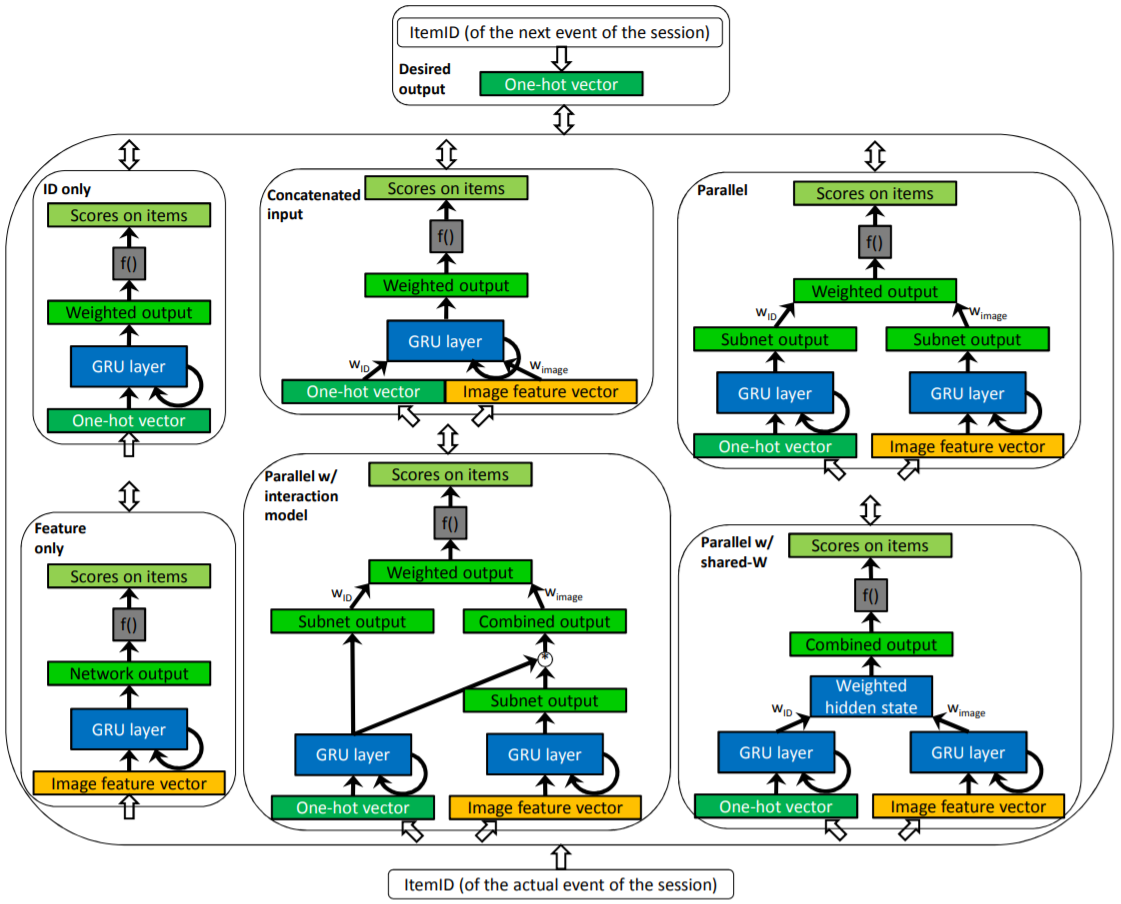GRU4RecF¶
Introduction¶
Title: Parallel Recurrent Neural Network Architectures for Feature-rich Session-based Recommendations
Authors: Balázs Hidasi, Massimo Quadrana, Alexandros Karatzoglou, Domonkos Tikk
Abstract: Real-life recommender systems often face the daunting task of providing recommendations based only on the clicks of a user session. Methods that rely on user profiles – such as matrix factorization – perform very poorly in this setting, thus item-to-item recommendations are used most of the time. However the items typically have rich feature representations such as pictures and text descriptions that can be used to model the sessions. Here we investigate how these features can be exploited in Recurrent Neural Network based session models using deep learning. We show that obvious approaches do not leverage these data sources. We thus introduce a number of parallel RNN (p-RNN) architectures to model sessions based on the clicks and the features (images and text) of the clicked items. We also propose alternative training strategies for p-RNNs that suit them better than standard training. We show that p-RNN architectures with proper training have significant performance improvements over feature-less session models while all session-based models outperform the item-to-item type baseline.

Running with RecBole¶
Model Hyper-Parameters:
embedding_size (int): The embedding size of items. Defaults to64.hidden_size (int): The number of features in the hidden state. Defaults to128.num_layers (int): The number of layers in GRU. Defaults to1.dropout_prob (float): The dropout rate. Defaults to0.3.selected_features (list): The list of selected item features. Defaults to['class']for ml-100k dataset.pooling_mode (str): The intra-feature pooling mode. Defaults to'sum'. Range in['max', 'mean', 'sum'].loss_type (str): The type of loss function. If it set to'CE', the training task is regarded as a multi-classification task and the target item is the ground truth. In this way, negative sampling is not needed. If it set to'BPR', the training task will be optimized in the pair-wise way, which maximize the difference between positive item and negative item. In this way, negative sampling is necessary, such as setting--neg_sampling="{'uniform': 1}". Defaults to'CE'. Range in['BPR', 'CE'].
A Running Example:
Write the following code to a python file, such as run.py
from recbole.quick_start import run_recbole
parameter_dict = {
'neg_sampling': None,
}
run_recbole(model='GRU4RecF', dataset='ml-100k', config_dict=parameter_dict)
And then:
python run.py
Notes:
GRU4RecF is a sequential model that integrates item context information.
selected_featurescontrols the used item context information. The used context information must be in the dataset and be loaded by data module in RecBole. It means the value inselected_featuresmust appear inload_col.
Tuning Hyper Parameters¶
If you want to use HyperTuning to tune hyper parameters of this model, you can copy the following settings and name it as hyper.test.
learning_rate choice [0.01,0.005,0.001,0.0005,0.0001]
num_layers choice [1, 2]
Note that we just provide these hyper parameter ranges for reference only, and we can not guarantee that they are the optimal range of this model.
Then, with the source code of RecBole (you can download it from GitHub), you can run the run_hyper.py to tuning:
python run_hyper.py --model=[model_name] --dataset=[dataset_name] --config_files=[config_files_path] --params_file=hyper.test
For more details about Parameter Tuning, refer to Parameter Tuning.
If you want to change parameters, dataset or evaluation settings, take a look at